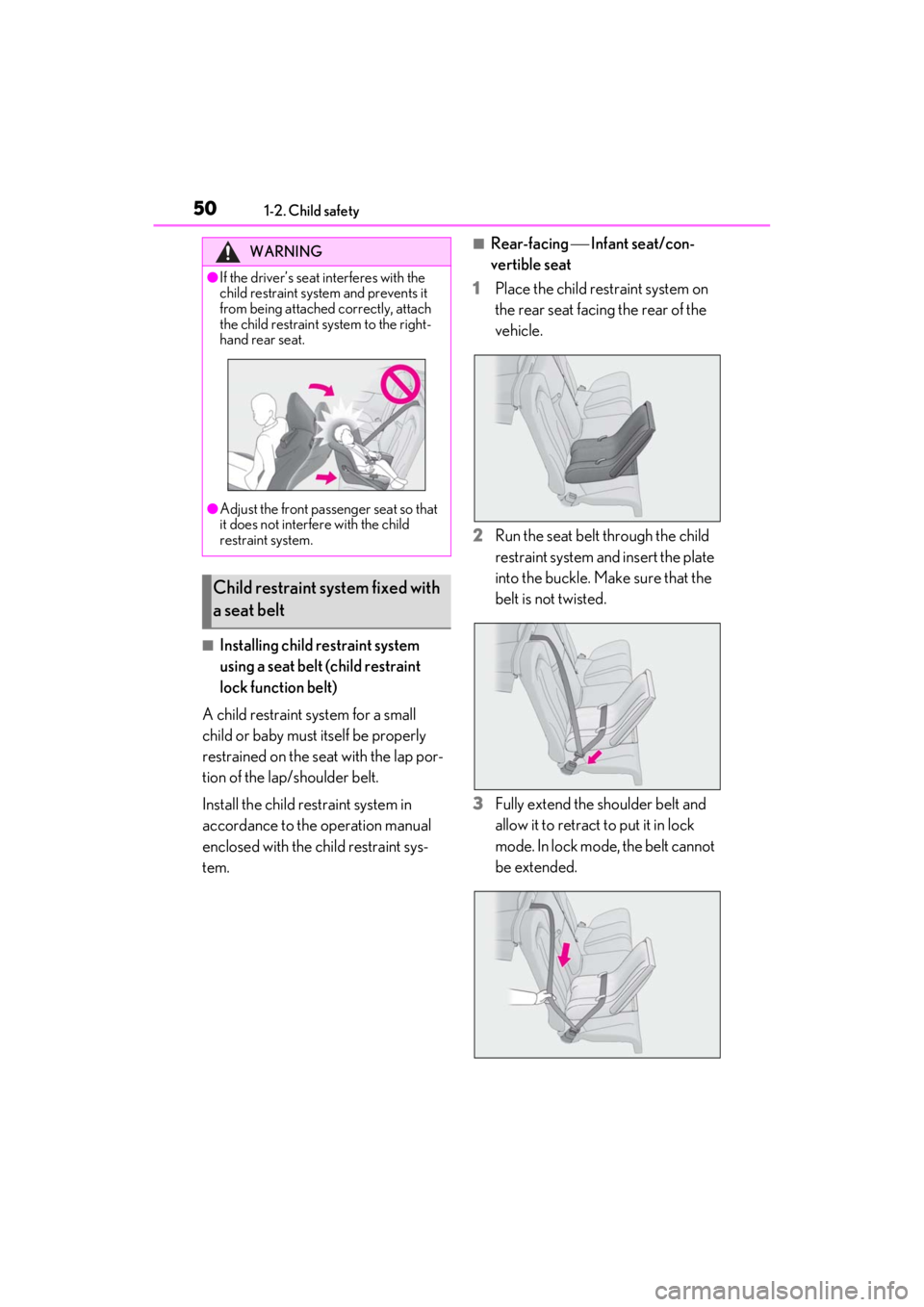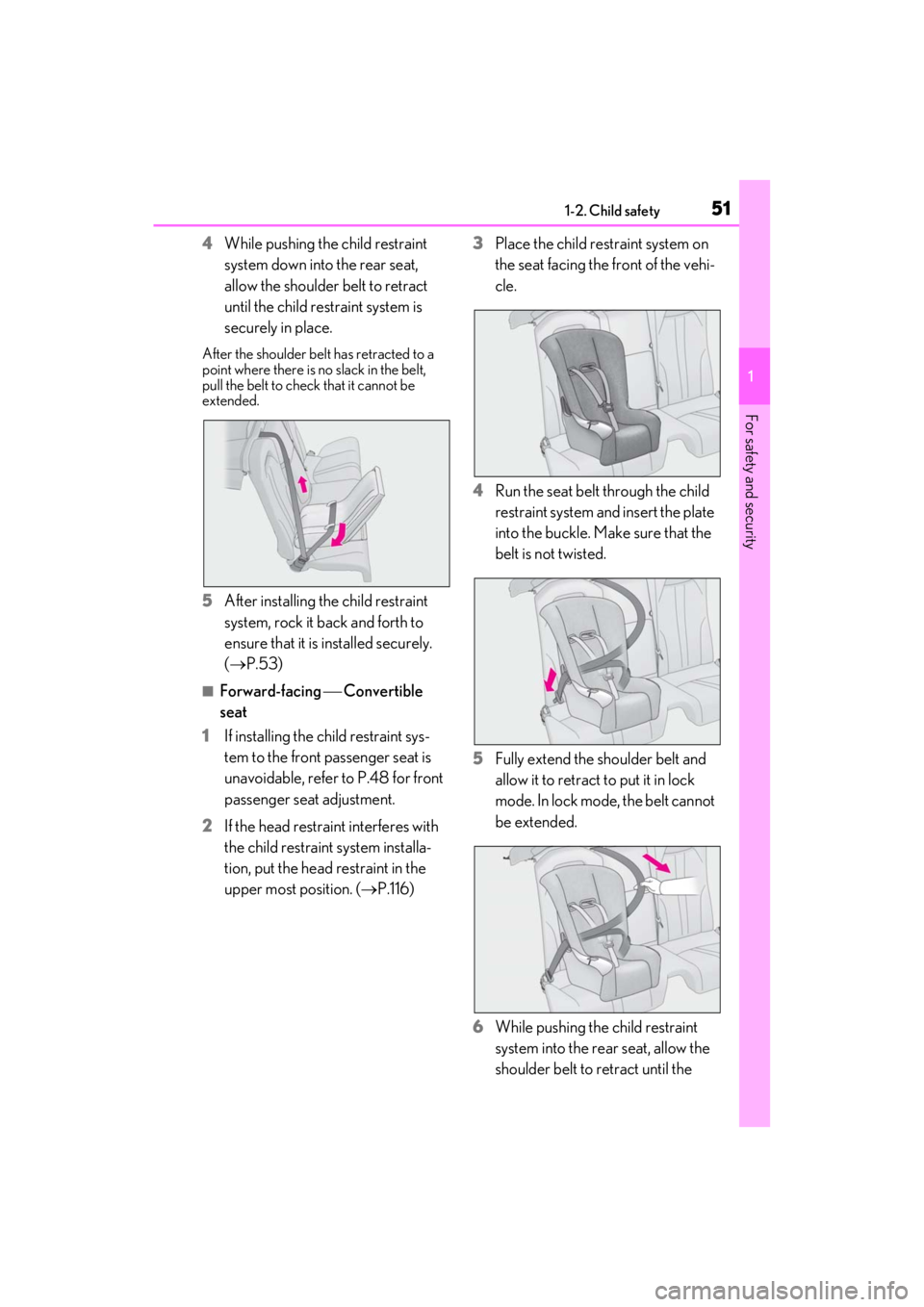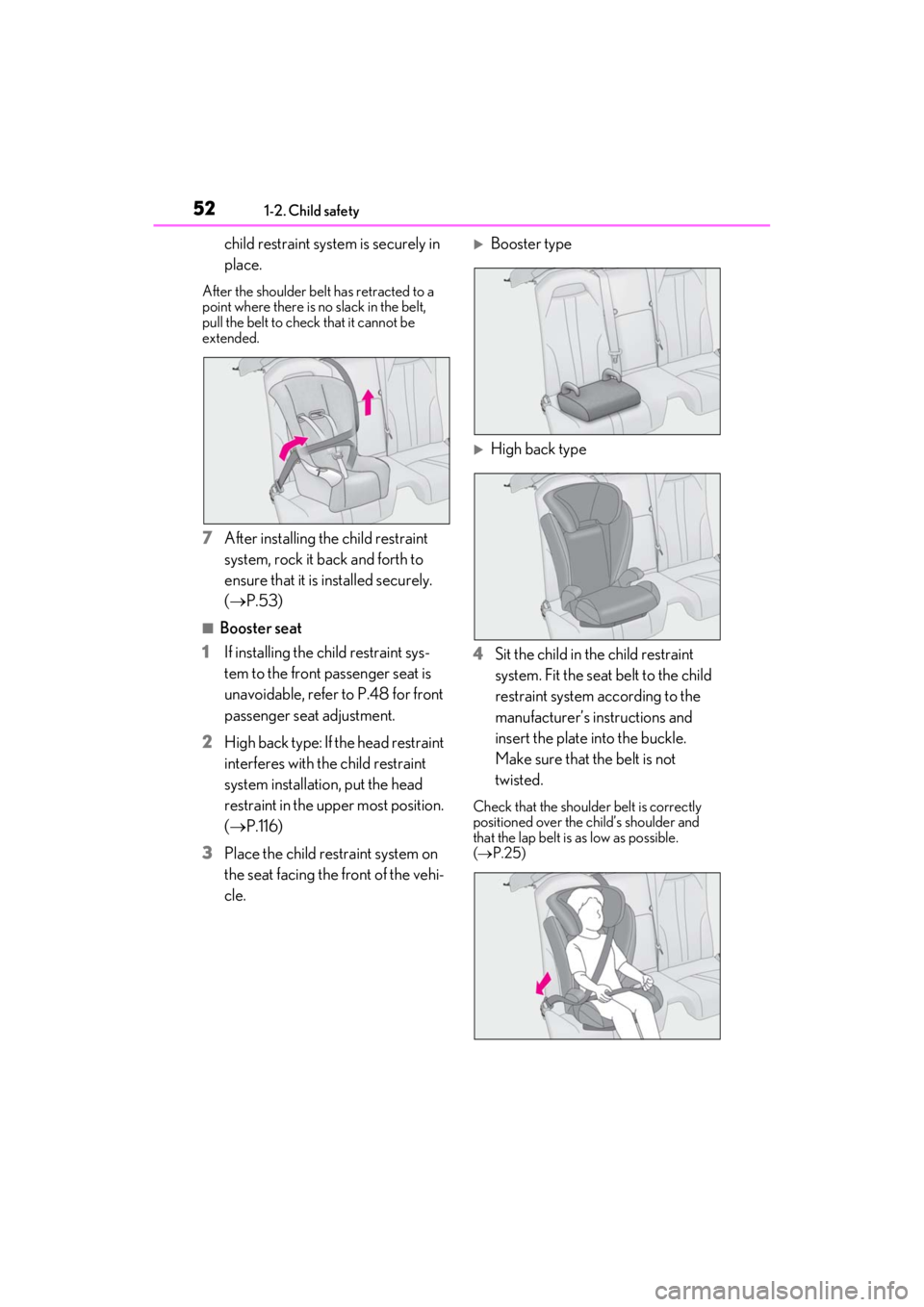2021 Lexus LC500C child seat
[x] Cancel search: child seatPage 52 of 410

501-2. Child safety
■Installing child restraint system
using a seat belt (child restraint
lock function belt)
A child restraint system for a small
child or baby must itself be properly
restrained on the seat with the lap por-
tion of the lap/shoulder belt.
Install the child restraint system in
accordance to the operation manual
enclosed with the child restraint sys-
tem.
■Rear-facing Infant seat/con-
vertible seat
1
Place the child restraint system on
the rear seat facing the rear of the
vehicle.
2
Run the seat belt through the child
restraint system and insert the plate
into the buckle. Make sure that the
belt is not twisted.
3
Fully extend the shoulder belt and
allow it to retract to put it in lock
mode. In lock mode, the belt cannot
be extended.
WARNING
●If the driver’s seat interferes with the
child restraint system and prevents it
from being attached correctly, attach
the child restraint system to the right-
hand rear seat.
●Adjust the front passenger seat so that
it does not interfere with the child
restraint system.
Child restraint system fixed with
a seat belt
Page 53 of 410

511-2. Child safety
1
For safety and security
4While pushing the child restraint
system down into the rear seat,
allow the shoulder belt to retract
until the child restraint system is
securely in place.
After the shoulder belt has retracted to a
point where there is no slack in the belt,
pull the belt to check that it cannot be
extended.
5After installing the child restraint
system, rock it back and forth to
ensure that it is installed securely.
(P.53)
■Forward-facing Convertible
seat
1 If installing the child restraint sys-
tem to the front passenger seat is
unavoidable, refer to P.48 for front
passenger seat adjustment.
2 If the head restraint interferes with
the child restraint system installa-
tion, put the head restraint in the
upper most position. ( P.116) 3
Place the child restraint system on
the seat facing the front of the vehi-
cle.
4 Run the seat belt through the child
restraint system and insert the plate
into the buckle. Make sure that the
belt is not twisted.
5 Fully extend the shoulder belt and
allow it to retract to put it in lock
mode. In lock mode, the belt cannot
be extended.
6 While pushing the child restraint
system into the rear seat, allow the
shoulder belt to retract until the
Page 54 of 410

521-2. Child safety
child restraint system is securely in
place.
After the shoulder belt has retracted to a
point where there is no slack in the belt,
pull the belt to check that it cannot be
extended.
7After installing the child restraint
system, rock it back and forth to
ensure that it is installed securely.
(P.53)
■Booster seat
1 If installing the child restraint sys-
tem to the front passenger seat is
unavoidable, refer to P.48 for front
passenger seat adjustment.
2 High back type: If the head restraint
interferes with the child restraint
system installation, put the head
restraint in the upper most position.
(P.116)
3 Place the child restraint system on
the seat facing the front of the vehi-
cle.
Booster type
High back type
4 Sit the child in the child restraint
system. Fit the seat belt to the child
restraint system according to the
manufacturer’s in structions and
insert the plate into the buckle.
Make sure that the belt is not
twisted.
Check that the shoulder belt is correctly
positioned over the child’s shoulder and
that the lap belt is as low as possible.
( P.25)
Page 55 of 410

531-2. Child safety
1
For safety and security
■Removing a child restraint system
installed with a seat belt
Press the buckle release button and
fully retract the seat belt.
When releasing the buckle, the child
restraint system may spring up due to the
rebound of the seat cushion. Release the
buckle while holding down the child
restraint system.
Since the seat belt automatically reels itself,
slowly return it to the stowing position.
■Child restraint LATCH anchors
LATCH anchors are provided for the
each rear seat. (Buttons displaying the
location of the anchors are attached to
the seats.)
WARNING
■When installing a child restraint sys-
tem
Observe the following precautions.
Failure to do so may result in death or
serious injury.
●Do not allow children to play with the
seat belt. If the seat belt becomes
twisted around a child’s neck, it may
lead to choking or other serious inju-
ries that could result in death. If this
occurs and the buckle cannot be
unfastened, scissors should be used to
cut the belt.
●Ensure that the belt and plate are
securely locked and the seat belt is not
twisted.
●Shake the child restraint system left
and right, and forward and backward
to ensure that it has been securely
installed.
●After securing a child restraint system,
never adjust the seat.
●When a booster seat is installed,
always ensure that th e shoulder belt is
positioned across the center of the
child’s shoulder. The belt should be
kept away from the child’s neck, but
not so that it could fall off the child’s
shoulder.
●Follow all installation instructions pro-
vided by the child restraint system
manufacturer.
■When installing a booster seat
To prevent the belt from going into ALR
lock mode, do not fully extend the shoul-
der belt. ALR mode causes the belt to
tighten only. This could cause injury or
discomfort to the child. ( P.26)
■Do not use a seat belt extender
If a seat belt extender is used when
installing a child restra int system, the seat
belt will not securely hold the child
restraint system, which could cause
death or serious injury to the child or
other passengers in the event of sudden
braking, sudden swerving or an accident.
Child restraint system fixed with
a child restraint LATCH anchor
Page 56 of 410

541-2. Child safety
■When installing in the rear seats
Install the child restraint system in
accordance to the operation manual
enclosed with the child restraint sys-
tem.
With flexible lower attachments
1 Latch the hooks of the lower
attachments onto the LATCH
anchors.
For owners in Canada:
The symbol on a child restraint sys-
tem indicates the presence of a
lower connector system.
With rigid lower attachments
1 Latch the buckles onto the LATCH
anchors.
For owners in Canada:
The symbol on a child restraint sys-
tem indicates the presence of a
lower connector system.
2 After installing the child restraint
system, rock it back and forth to
ensure that it is installed securely.
(P.53)
■Laws and regulations pertaining to
anchors
The LATCH system conforms to
FMVSS225 or CMVSS210.2.
Child restraint systems conforming to
FMVSS213 or CMVSS213 specifications
can be used.
This vehicle is designed to conform to SAE
J1819.
A
A
Page 57 of 410

551-2. Child safety
1
For safety and security
WARNING
■When installing a child restraint sys-
tem
Observe the following precautions.
Failure to do so may result in death or
serious injury.
●When using the LATCH anchors, be
sure that there are no foreign objects
around the anchors and that the seat
belt is not caught behind the child
restraint system.
●Follow all installation instructions pro-
vided by the child restraint system
manufacturer.
●If the seat is adju sted, reconfirm the
security of the child restraint system.
Page 135 of 410

1333-6. Opening and closing the soft top roof
3
Before driving
WARNING
●When exiting the vehicle, turn the
engine switch off, carry the key and
exit the vehicle along with the child.
There may be accidental operation,
due to mischief, etc., that may possibly
lead to an accident.
■While the vehicle is driven
Observe the following precautions.
Failure to do so may result in serious
injury or an accident.
●Do not operate the soft top roof more
than necessary.
●Do not drive the vehicle with the soft
top roof half-opened.
●Do not stand on the seat, sit on the
package tray ( P.40), or lean out of
the vehicle.
■When a child is in the vehicle
Observe the following precautions.
Failure to do so may result in death or
serious injury.
●Do not allow a child operate the soft
top roof.
●Never let a child sit in the storing
space of the soft top roof.
●Keep children away from the movable
range of the soft top roof.
NOTICE
■To prevent damage to the soft top
roof
●Make sure that ther e is no obstacle
within a height of 25.6 in. (65 cm)
from the soft top roof.
Also, be careful when passing a place
with height restriction, such as a tunnel
or underground passage.
●Do not put anything in the storing
space of the soft top roof.
●Do not sit on or put luggage on the soft
top roof or luggage cover.
●When there is snow or luggage on the
soft top roof or luggage cover, remove
it before operating the roof switch.
●Do not open or close the soft top roof
when anything is put on the trunk lid.
●Do not close the soft top roof when
anything is put on the upper part of the
windshield frame.
●Do not open or close the soft top roof
when the outside temperature is
23.0°F (-5°C) or lower or the side
windows and rear quarter windows
are frozen.
●Do not leave the soft top roof not fully
opened or closed for a long period of
time.
●Do not leave the soft top roof opened
for a long period of time. The soft top
roof may have wrinkles or deteriorate.
●When opening the trunk lid using the
mechanical key, full y open or close the
soft top roof.
●Do not install a roof luggage carrier to
the soft top roof.
●Do not operate the soft top roof manu-
ally except in an emergency.
( P.338)
Page 161 of 410

1594-2. Driving procedures
4
Driving
Turns the brake hold system on
The brake hold standby indicator
(green) comes on. While the system is
holding the brake, the brake hold operated
indicator (yellow) comes on.
■Brake hold system operating conditions
The brake hold system cannot be turned on
in the following conditions:
●The driver’s door is not closed.
●The driver is not wearing the seat belt.
●“EPB Activation Stopped Incompletely”
or “EPB Malfunction Visit your dealer” is
displayed on the multi-information dis-
play.
If any of the conditions above are detected
when the brake hold system is enabled, the
system will turn off and the brake hold
WARNING
■When parking the vehicle
Do not leave a child in the vehicle alone.
The parking brake may be released unin-
tentionally and there is the danger of the
vehicle moving that may lead to an acci-
dent resulting in death or serious injury.
NOTICE
■When parking the vehicle
Before you leave the vehicle, shift the
shift position to P, set the parking brake
and make sure that the vehicle does not
move.
■When the system malfunctions
Stop the vehicle in a safe place and
check the warning messages.
■When the parking brake cannot be
released due to a malfunction
Driving the vehicle with the parking
brake set will lead to brake components
overheating, which may affect braking
performance and increase brake wear.
Have the vehicle inspected by your
Lexus dealer immediately if this occurs.
Brake Hold
The brake hold system keeps the
brake applied when the shift posi-
tion is in D, M or N with the system
on and the brake pedal has been
depressed to stop the vehicle. The
system releases the brake when the
accelerator pedal is depressed with
the shift position in D or M to allow
smooth start off.
Enabling the system
A
B